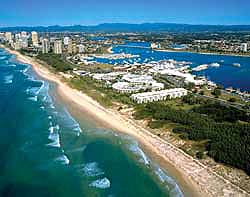More storms and surges with warmer conditions

Sea-level rise and changes to cyclone intensity under enhanced greenhouse conditions would pose a considerable increase in risk to coastal property and infrastructure, according to a recent CSIRO study.
Dr John Church, of CSIRO and the Antarctic Climate and Ecosystems CRC, said a recent study had confirmed that sea-level in the Australian region was rising at rates which would have a significant impact over decades to come.
Speaking at the Coast to Coast 04 conference in Hobart today, Dr Church said a recent analysis for Cairns showed the North Queensland city would be subject to impacts such as storm surges and severe wave conditions.
“The perception is that the main impact is going to be flooding through a combination of longer-term sea-level rise and king tides,” Dr Church said.
“Our analysis is that infrastructure and resource managers in coastal communities need to also factor in a third component likely under global warming – extreme storms.
“Put extreme storms, king tides and long-term sea-level rise together and you have a package that the insurance industry recognises will produce high-cost storms and floods in Australia and New Zealand.”
Dr Church was a lead author on sea-level rise for the Third Assessment Report of the Intergovernmental Panel on Climate Change released in 2000.
He said the report concluded that it was very likely that the 20th century warming has contributed significantly to the observed sea-level rise through thermal expansion of sea water and widespread loss of land ice.
“Sea-level rise has the potential to affect millions of people living in low lying coastal regions, particularly the inhabitants of mega cities developing on coasts around the world and those living on deltas of major rivers and small island nations,” he said.
“For the 21st century, thermal expansion of the oceans is likely to make the largest contribution to sea-level rise.”
The research was conducted by Dr Church, Dr John Hunter, Dr Kathleen McInnes and Dr Neil White, scientists at CSIRO and the Hobart-based Antarctic Climate and Ecosystems Cooperative Research Centre.
In their study of impacts on Australian coastal communities from climate change, Dr Church and his colleagues analysed Australian sea-level records for the period 1920 to 2000.
They drew their basic data from records obtained from tide gauges at Fremantle, Sydney and other locations. These indicated a minimum in the rate of sea-level rise from the mid-1970’s to the mid-1990’s. An assessment for the period 1950 to 2000 showed that sea-level rise around Australia was less than the global average, a result of the trend to more frequent, persistent and intense events since the mid-1970’s. This lower rate of sea-level rise around Australia is not likely to continue indefinitely.
Averaged around Australia, relative sea-level rise for the period 1920 to 2000 was about 1.2 mm/year compared to 1.8 mm/year for the period 1950 to 2000 averaged around the world.
More information:
Dr John Church, 03 6232 5207
Media assistance:
Craig Macaulay, Marine Research, 03 6232 5219 or 0419 966 465
Coast to Coast 04 conference media contact:
Jess Tyler, 0408 298 292
Media Contact
More Information:
http://www.csiro.au/index.asp?type=mediaRelease&id=prsealevelsAll latest news from the category: Ecology, The Environment and Conservation
This complex theme deals primarily with interactions between organisms and the environmental factors that impact them, but to a greater extent between individual inanimate environmental factors.
innovations-report offers informative reports and articles on topics such as climate protection, landscape conservation, ecological systems, wildlife and nature parks and ecosystem efficiency and balance.
Newest articles

First-of-its-kind study uses remote sensing to monitor plastic debris in rivers and lakes
Remote sensing creates a cost-effective solution to monitoring plastic pollution. A first-of-its-kind study from researchers at the University of Minnesota Twin Cities shows how remote sensing can help monitor and…

Laser-based artificial neuron mimics nerve cell functions at lightning speed
With a processing speed a billion times faster than nature, chip-based laser neuron could help advance AI tasks such as pattern recognition and sequence prediction. Researchers have developed a laser-based…

Optimising the processing of plastic waste
Just one look in the yellow bin reveals a colourful jumble of different types of plastic. However, the purer and more uniform plastic waste is, the easier it is to…



